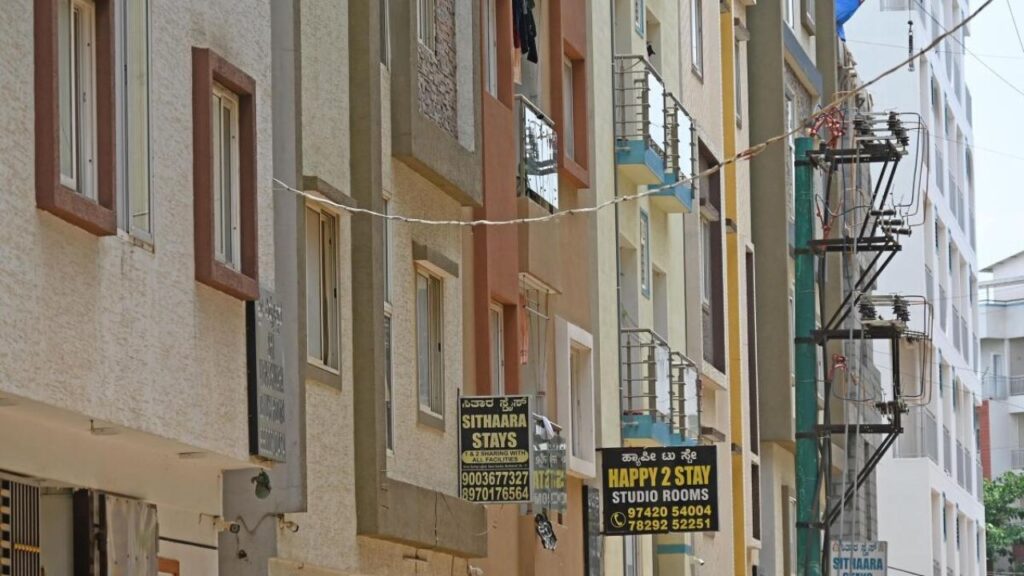Bengaluru, once known as a thriving hub for paying guest (PG) accommodations, is facing a sharp downturn. A combination of stringent municipal regulations, rising operational costs, and enforcement crackdowns has led to the closure of over 200 PG facilities, pushing many owners into financial distress. Once considered a lucrative real estate investment, the sector is now witnessing mounting challenges with owners reporting losses of 20–30%.

BBMP’s Regulatory Overhaul Hits PG Sector
In a move aimed at bringing order to the unregulated PG industry, the Bruhat Bengaluru Mahanagara Palike (BBMP) implemented strict guidelines under Section 305 of the BBMP Act, 2020. These include:
- Mandatory CCTV surveillance at all entry/exit points and common areas
- Minimum 70 sq ft per resident as livable space
- 135 litres of water per day per resident requirement
- FSSAI licensing within three months for PGs offering food or kitchen access
These new norms, though aimed at improving living conditions and safety, have made operations costly and complicated for thousands of PG owners.
Illegal PG Operations & Zoning Violations
According to Sukhi Seo, Secretary of the Bengaluru PG Owners’ Association:
“Only around 2,500 PGs in Bengaluru are certified. The rest—over 10,000—are functioning without proper approvals. This poses a huge risk to investors, as BBMP has the authority to raid and shut down non-compliant properties at any time.”
BBMP has also acted decisively—100 kitchens in PGs were recently shut down in Mahadevapura for violating town planning and licensing norms. Most of these operations are running in residential areas with roads narrower than the 40-feet threshold required for commercial activity.
Financial Losses for PG Owners
Once yielding 6–8% ROI, far outpacing the 3–4% return from rental apartments, PG accommodations attracted rapid investments. However, the tide has turned.
Key Reasons for Financial Distress:
- Electricity at commercial rates
- Increased water charges from Bangalore Water Supply and Sewerage Board
- Cap on rental pricing, with tenants reluctant to accept higher rates
- Rising compliance costs due to new BBMP mandates
“In prime areas, rents are already ₹10,000–₹15,000 for double sharing. If we raise it any further, tenants leave. At the same time, operational costs have skyrocketed,” Seo noted.
Unregulated Growth and Civic Concerns
Civic activists are sounding alarms over the PG boom that ignored zoning and infrastructure norms.
“In areas like Whitefield, PGs have nearly double the permitted floors. This overstretches local infrastructure and leads to unsafe, dense living conditions,” said Sandeep Anirudhan, Convenor of the Coalition for Water Security.
He added that PG buildings frequently avoid fire safety norms and overstep height limits, further complicating regulatory oversight.
Summary Table: Bengaluru PG Market Crisis Highlights
| Key Issue | Details |
|---|---|
| Total PGs in Bengaluru | Over 12,000 (only ~2,500 certified) |
| Recent Closures | 200+ PGs shut down |
| Common Owner Losses | 20–30% |
| ROI Decline | From 6–8% to negative returns for many |
| Key Regulations Introduced | CCTV, water per capita, space per resident, FSSAI license for food PGs |
| Enforcement Action | 100+ kitchens shut down, zoning violations cited |
FAQs on Bengaluru’s PG Crisis
1. Why are PGs shutting down in Bengaluru?
Due to new BBMP regulations, high operational costs, and enforcement on illegal structures, over 200 PGs have closed operations.
2. What are the new BBMP rules for PG accommodations?
Rules include CCTV installation, 70 sq ft per resident, 135 litres of water per person daily, and mandatory FSSAI licensing for food service.
3. Are most PGs in Bengaluru operating legally?
No. Out of over 12,000 PGs, only around 2,500 are certified. The rest operate without proper licences, raising risks of raids and shutdowns.
4. What has caused financial losses for PG owners?
Higher water and electricity charges, regulatory compliance costs, and inability to raise rents without losing tenants have contributed to 20–30% losses.
5. What is the future outlook for the PG sector?
Unless regulations are streamlined and compliance is enforced uniformly, the sector may continue to struggle with closures and reduced investment interest.
